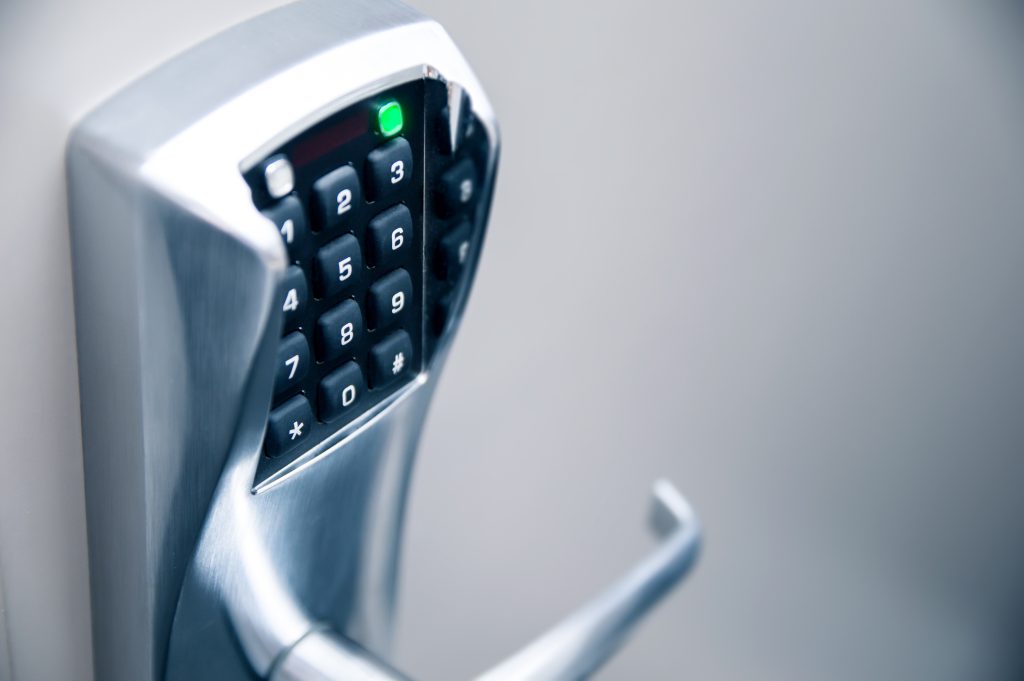- There are several types of keyless electronic door locks, including keypads, fobs or keycards and biometric locks.
- Integrations for keyless electronic door locks include surveillance security and smart devices.
- High-quality keyless electronic door locks cost between $100 and $800.
- This article is for small business owners seeking an alternative to issuing keys so employees can enter and exit the workplace.
At least one of your employees is bound to lose their key at some point, and keys ― whether a traditional metal key or a nifty fob ― can be costly and cumbersome to replace.
Keyless electronic door locks can make your life as a business owner easier by eliminating the need for physical keys. Besides increasing security, they save you time and money ― you no longer need to get a new key made when an employee loses one or change the locks when a staff member leaves the company. Instead, you change their code directly from your management system.
Editor’s note: Need an access control system for your business? Fill out the below questionnaire to have our vendor partners contact you with free information.
You have many options for keyless electronic door locks, so you can choose one that is right for your business. Read on for details about the various keyless electronic door lock types and their features, pricing information and more.
How keyless door locks work
Just like a regular lock and key mechanism, keyless door locks open and close entryways throughout your facility. The only difference is that you don’t insert a physical key into a lock. Depending on the keyless door lock model you select, employees will punch in a code, present a key fob or keycard or use biometrics, such as their thumbprint or face, to unlock the door. The lock typically remains unlocked for a few seconds after it’s opened and relocks automatically when the door shuts.
Physical security is crucial to cybersecurity. Cyberattacks often stem from poor access management.
Benefits of keyless door locks
Below are four benefits businesses gain when switching to keyless door locks:
- Keyless door locks add convenience: Allowing a new hire into the building can be as simple as generating a code or entering their information into the system. You no longer have to make a key or change the locks when a staff member leaves. You also won’t have to worry about having a designated person open and close your facility daily.
- Keyless door locks add security: Keyless door locks provide greater control over who is allowed access to certain parts of your building, whether the front door or restricted areas throughout the office. They can also provide insight into who is entering and exiting the building.
- Keyless door locks integrate with access control systems: You can program keyless door locks to let only specific employees in or out during certain times of the day, such as during regular business hours.
- Keyless door locks last longer than traditional locks: All that turning and metal on metal wears down regular door locks. Keyless door locks don’t undergo the same level of wear and tear.
Types of keyless electronic door locks
Every business is unique, so the type of lock you choose will depend on your business’ needs and each lock’s capabilities.
Many locks, regardless of type, offer multiple keyless ways to unlock the door in the event of a lost key or forgotten code.
Keypad/combination locks
A keypad/combination lock model requires a PIN to unlock the door. They are very easy to install and maintain, and you can assign different codes to different users. You can change the PIN at any time, allowing you to manage access to your building easily.
Some models have protective mechanisms, such as keypads that shut down after an incorrect code has been entered three times. Most newer models have a touchscreen but some have physical buttons. There are also combination keypad locks that use a PIN in conjunction with another type of lock, such as deadbolts or handles.
Keyless and wireless smart locks
Keyless and wireless smart locks are also popular options. They allow you to connect to your locks over a Wi-Fi connection so you can control them from anywhere in the world via a mobile app or remote. However, unless you purchase your locks as part of a smart office package, they may not come with a dedicated mobile app.
Many smart locks offer Bluetooth capability, which can unlock your doors automatically once you get within a certain distance. You may also be able to use your phone or a key fob and tap the sensor to unlock the door.
Smart offices include various technologies powered by machine learning, smart sensors and high-level communication and collaboration tools.
Key fobs and keycards
Key fobs or keycards unlock a Bluetooth or radio frequency identification-enabled smart lock. You tap the fob or card against the lock sensor to disarm it. Key fobs and cards can be programmed to unlock multiple locks so, for example, your one key fob can let you into the front, side and doors of your building.
Biometric locks
Biometric locks are a popular, up-and-coming electronic door lock option. You can unlock a door by having your fingerprint or (less commonly) eye scanned. Biometric locks are a secure option because fingerprints (and irises) are unique and difficult to forge. They’re also a convenient option for individuals because they don’t have to carry a key fob, which means they always have access.
Biometric door locks scan a fingerprint and convert it into a numerical template, which tells the system to unlock the door. Because this system depends on connectivity, look for a model with a backup option like a keypad or mechanical lock so you can still gain entry if your fingerprint can’t be scanned.
Many models have a storage limit of 100 fingerprints, so if your company is larger, a biometric lock may not be the best option for you.
Biometric technology is also used in time and attendance systems and employee-tracking apps.
How to choose an electronic keyless door lock
When choosing a keyless lock, the first thing to determine is which type suits your business best. A keypad lock often works well if you don’t want to give people physical keys, fobs or access cards.
You must consider how many codes you’ll need; many models are limited by the number of codes they support. You must also decide if you need a dedicated mobile app that allows you to lock or unlock your doors, receive mobile alerts or control your locks remotely.
The next step is determining which features are must-haves and which you can do without. Last, what credentials do you want ― key fobs, a smartphone app, keycards or something else?
Consider the following features to look for when choosing an electronic keyless door lock:
- Low-battery indicator: No matter which type of keyless door lock you choose, look for one with a low-battery indicator that alerts you when the battery must be replaced. Some models have an indicator light that appears, whereas, with other locks, you may notice slower response times or multiple attempts needed to open the door when the battery gets low. A low-battery indicator is an essential feature because it will help you avoid being locked out due to a dead battery.
- Integrations: Consider which integrations you’ll need. Many people like to have their door locks integrated with Alexa, Google Home, IFTTT (If This, Then That), Wink or SmartThings, but not all locks can do that. Also, consider whether you need the lock to integrate with a security system or connect to video surveillance systems, cameras, alarms and more.
- Durability: Durability is key. Because the lock will likely be outside, it’s susceptible to weather extremes and vandalism. Check whether the lock is waterproof, coldproof, heat-resistant and more and if there is a guarantee against damage caused by vandalism.
- Pricing: The price of a keyless electronic door lock depends on functionality, features, installation, connectivity, required equipment and how many locks you will need. Based on the dozens of models we examined, quality models range in cost from $100 to $800.
Aside from keyless door locks, other types of business security equipment to consider include security cameras, comprehensive security systems and lighting systems.
Keyless electronic door lock FAQs
How secure are keyless door locks?
You may assume that the high-tech nature of a keyless electronic door lock makes it more secure, but that’s not always the case. A keyless door lock is no more effective than a regular lock and key ― just more convenient.
What do I do if the battery dies?
We recommend a lock with a low-battery warning. However, if the batteries die, review the manual to see how you can override the lock.
Can keyless door locks be hacked?
Like any internet-connected device, a keyless door lock may be hacked. However, following recommended safety protocol minimizes the chances of such an incident. For example, create strong passwords and never distribute them via email or text, where they can be intercepted by bad actors.
Will the lock stop working when the power goes out?
No. Electronic locks continue working because they run on batteries. However, look for a model with an analog backup method, such as a deadbolt or a traditional key, so you have an alternate way to get into the building.
How technical are electronic door locks to install?
While what may be considered technical to one person may not be for another, manufacturers have worked hard to ensure installation is as straightforward as possible. Some companies offer step-by-step instructions with photos or video tutorials.
Does the lock need to be wired?
Any battery-operated keyless door lock does not need to be wired. None of the models we looked at needed to be hardwired. Wireless options have become popular due to their ease of installation and maintenance and most providers offer a wireless option.
The right keyless electronic door is within reach
On its face, the phrase “keyless door” might seem like the future. However, in reality, this is quite everyday technology. A keyless door is just a battery-powered lock that cards, key fobs, numeric codes, smart locks or biometric scans open. Plus, if your batteries die, your lock will offer manual overrides. There are other features worth noting too ― it’s always best to speak with an expert and read reviews before making your decision.
Max Freedman contributed to this article.
Read the full article here










